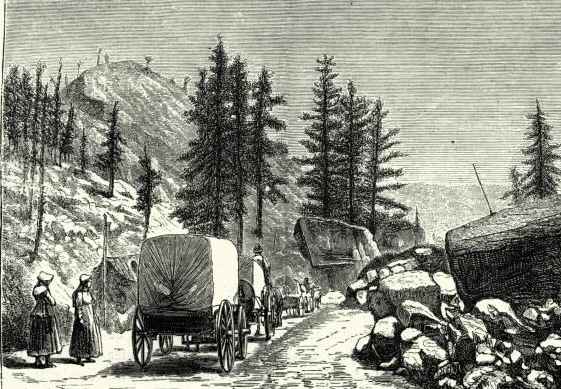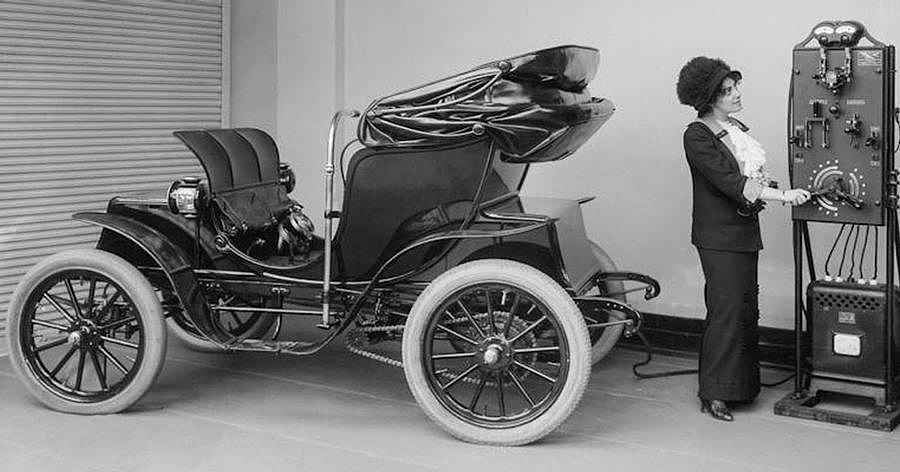






See listing of Recent and Most Popular articles on the Home Page
My World
Category: Technology / Topics: Circumstances, Life Events • Coping • History • Innovation, Invention, Creativity • Opportunity • Predictions & Forecasts • Science & Technology • Technology • Transportation • Trends
The Lost History of the Electric Car
from The Guardian
Posted: August 21, 2021
And what it tells us about the future of transport…
The Problem with Horses
In the 1890s, the biggest cities of the western world faced a mounting problem. Horse-drawn vehicles had been in use for thousands of years, and it was hard to imagine life without them. But as the number of such vehicles increased during the 19th century, the drawbacks of using horses in densely populated cities were becoming ever more apparent.
In particular, the accumulation of horse manure on the streets, and the associated stench, were impossible to miss. By the 1890s, about 300,000 horses were working on the streets of London, and more than 150,000 in New York City. Each of these horses produced an average of 10kg of manure a day, plus about a litre of urine. Collecting and removing thousands of tonnes of waste from stables and streets proved increasingly difficult.
The problem had been building up for decades. A newspaper editor in New York City said in 1857 that “with the exception of a very few thoroughfares, all the streets are one mass of reeking, disgusting filth, which in some places is piled to such a height as to render them almost impassable to vehicles”. As well as filling the air with a terrible stench, the abundance of horse manure turned streets into muddy cesspools whenever it rained. An eyewitness account from London in the 1890s describes the “mud” (the accepted euphemism among prudish Victorians) that often flooded the Strand, one of the city’s main thoroughfares, as having the consistency of thick pea soup. Passing vehicles “would fling sheets of such soup – where not intercepted by trousers or skirts – completely across the pavement”, spattering and staining nearby houses and shop fronts. Manure collected from the streets was piled up at dumps dotted around major towns and cities. Huge piles of manure also built up next to stables and provided an attractive environment for flies.
All of this was bad for public health. The board of health’s statisticians in New York City found higher levels of infectious disease “in dwellings and schools within 50 feet of stables than in remoter locations”, the New York Times reported in 1894. According to one turn-of-the-century calculation, 20,000 New Yorkers died annually from “maladies that fly in the dust”, clear evidence of the dangers posed to health by reliance on horses. To make matters worse, horses were frequently overworked, and when they dropped dead, their bodies were often left rotting on the streets for several days before being dismembered and removed, posing a further health risk. By the 1880s, 15,000 dead horses were being removed from the streets of New York City each year.
Paradoxically, the advent of the steam locomotive and the construction of intercity railway links, starting in the 1830s, had helped make the problem worse. Faster and more efficient transport between cities increased the demand for rapid transport of people and goods within them, which required a greater number of horse-drawn vehicles. “Our dependence on the horse has grown almost pari passu [step for step] with our dependence on steam,” noted one observer in 1872. The result was more horses, more manure – and steadily worsening congestion.
. . . .
Horses had become both indispensable and unsustainable. To advocates of a newly emerging technology, the solution seemed obvious: get rid of horses and replace them with self-propelling motor vehicles, known at the time as horseless carriages. Today, we call them cars.
In recent years this transition has been cited as evidence of the power of innovation, and an example of how simple technological fixes to seemingly intractable problems will show up just when they are needed – so there is no need to worry about climate change, for instance. Yet it should instead be seen as a cautionary tale in the other direction: that what looks like a quick fix today may well end up having far-reaching and unintended consequences tomorrow. The switch from horses to cars was not the neat and timely technological solution that it might seem, because cars changed the world in all kinds of unanticipated ways – from the geography of cities to the geopolitics of oil – and created many problems of their own.
Substituting one set of problems for another
Much of the early enthusiasm for the automobile stemmed from its promise to solve the problems associated with horse-drawn vehicles, including noise, traffic congestion and accidents. That cars failed on each of these counts was tolerated because they offered so many other benefits, including eliminating the pollution – most notably, horse manure – that had dogged urban thoroughfares for centuries.
But in doing away with one set of environmental problems, cars introduced a whole set of new ones. The pollutants they emit are harder to see than horse manure, but are no less problematic. These include particulate matter, such as the soot in vehicle exhaust, which can penetrate deep into the lungs; volatile organic compounds that irritate the respiratory system and have been linked to several kinds of cancer; nitrogen oxides, carbon monoxide and sulphur dioxide; and greenhouse gases, primarily carbon dioxide, that contribute to climate change. Cars, trucks and buses collectively produce around 17% of global carbon dioxide emissions. Reliance on fossil fuels such as petrol and diesel has also had far-reaching geopolitical ramifications, as much of the world became dependent on oil from the Middle East during the 20th century.
None of this could have been foreseen at the dawn of the automobile age. Or could it? Some people did raise concerns about the sustainability of powering cars using non-renewable fossil fuels, and the reliability of access to such fuels. Today, electric cars, charged using renewable energy, are seen as the logical way to address these concerns. But the debate about the merits of electric cars turns out to be as old as the automobile itself.
. . . .
Perhaps the most remarkable example, to modern eyes, of how things might have worked out differently for electric vehicles is the story of the Electrobat, an electric taxicab that briefly flourished in the late 1890s. The Electrobat had been created in Philadelphia in 1894 by Pedro Salom and Henry Morris, two scientist-inventors who were enthusiastic proponents of electric vehicles. In a speech in 1895, Salom derided “the marvelously complicated driving gear of a gasoline vehicle, with its innumerable chains, belts, pulleys, pipes, valves and stopcocks … Is it not reasonable to suppose, with so many things to get out of order, that one or another of them will always be out of order?”
[Read in the full version of the article the story of the rise and fall of the Electric Vehicle Company around the turn of the 20th century]
In the years that followed, as more people bought private cars, electric vehicles took on a new connotation: they were women’s cars. This association arose because they were suitable for short, local trips, did not require hand cranking to start or gear shifting to operate, and were extremely reliable by virtue of their simple design. As an advertisement for Babcock Electric vehicles put it in 1910, “She who drives a Babcock Electric has nothing to fear”. The implication was that women, unable to cope with the complexities of driving and maintaining petrol vehicles, should buy electric vehicles instead. Men, by contrast, were assumed to be more capable mechanics, for whom greater complexity and lower reliability were prices worth paying for powerful, manly petrol vehicles with superior performance and range.
. . . .
Henry Ford bought his wife, Clara, a Detroit Electric rather than one of his own Model Ts. Some men may have liked that electric cars’ limited range meant that the independence granted to their drivers was tightly constrained.
By focusing on women, who were a small minority of drivers – accounting for 15% of drivers in Los Angeles in 1914, for example, and 5% in Tucson – makers of electric cars were tacitly conceding their inability to compete with petrol-powered cars in the wider market.
That year, Henry Ford confirmed rumours that he was developing a low-cost electric car in conjunction with Thomas Edison. “The problem so far has been to build a storage battery of light weight which would operate for long distances without recharging,” he told the New York Times, putting his finger on the electric car’s primary weakness. But the car was repeatedly delayed, as Edison tried and failed to develop an alternative to the heavy, bulky lead-acid batteries used to power electric cars. Eventually, the entire project was quietly abandoned.
The photo illustrating this articles shows a woman operating a charger for an early electric vehicle. Notice the "tiller" steering instead of the more "manly" steering wheel.
The psychology of the gasoline powered car
The failure of electric vehicles in the early 20th century, and the emergence of the internal combustion engine as the dominant form of propulsion, had a lot to do with liquid fuel providing far more energy per unit mass than a lead-acid battery can. But the explanation is not purely technical. It also has a psychological component. Buyers of private cars, then as now, did not want to feel limited by the range of an electric vehicle’s battery, and the uncertainty of being able to recharge it.
In the words of the historian Gijs Mom, private cars in this period were primarily seen as “adventure machines” that granted freedom to their owners – and an electric vehicle granted less freedom than the petrol-powered alternative. “To possess a car is to become possessed of a desire to go far afield,” wrote one city-dwelling car enthusiast in 1903. Sales of electric cars peaked in the early 1910s. As internal combustion engines became more reliable, they left electric vehicles in the dust.
But as car ownership expanded dramatically during the 20th century, relying on oil turned out to have other costs. By the 1960s, American cars were, on average, three-quarters of a tonne heavier than those made in Europe and Japan, and their V8 engines had more than twice the engine capacity of the four-cylinder engines most prevalent elsewhere. As a result, they used a lot more fuel. An increasing proportion of that fuel came from imported oil. Imports, mostly from the Middle East, accounted for 27% of the US’s supply by 1973. In December that year the Middle Eastern members of Opec (the Organization of Petroleum Exporting Countries) cut off oil exports to the US in protest at its support for Israel in the Yom Kippur war. The price of oil surged, and the sudden reduction in supply resulted in higher petrol prices, the introduction of rationing, and long queues at gas stations. For the first time, American drivers realised they could not take the supply of petrol for granted. The oil shock led the government to introduce a national speed limit of 55mph, and fuel-economy standards that required US manufacturers to achieve an average fuel economy, across their entire product lines, of 18 miles per gallon by 1978, and 27.5 by 1985.
But American carmakers did little to change their products. By the late 70s, 80% of American-made cars still had V8 engines. In 1979, in a second oil shock, oil supplies from the Middle East were once again disrupted, this time as a result of the Islamic revolution in Iran and the outbreak the following year of the Iran-Iraq war. The actual production of oil barely fell, but prices soared and panic buying ensued. This second oil shock stimulated the demand for smaller cars.
Electric cars might have been expected to benefit from the concerns over the sustainability of gas-guzzlers. But electric-car technology had made little progress since the 1920s. The biggest problem remained the battery: lead-acid batteries were still heavy and bulky and could not store much energy per unit of weight. The most famous electric vehicles of the 1970s, the four-wheeled lunar rovers driven by American astronauts on the moon, were powered by non-rechargeable batteries because they only had to operate for a few hours.
Battery technology as the hope to revive electric vehicles
On Earth, attempts to revive electric cars as commercial products failed to get off the ground – until the emergence in the 90s of the rechargeable lithium ion battery. By 2003, Alan Cocconi and Tom Gage, two electric-car enthusiasts, had built an electric roadster called the tzero, powered by 6,800 camcorder batteries, capable of 0-60mph in less than four seconds and with a range of 250 miles. Tesla was founded to commercialise that technology.
Lithium-ion batteries have made the switch to electric cars possible, but because of tightening regulation of combustion-powered vehicles in order to address climate change, that switch now seems inevitable.
The automobile, having been introduced in part to address one pollution problem, has contributed to another one: carbon dioxide emissions from the burning of fossil fuels.
To what extent will electrifying road vehicles help address the climate crisis? Globally, transport (including land, sea and air) accounts for 24% of carbon dioxide emissions from burning fossil fuels. Emissions from road vehicles are responsible for 17% of the global total. Of those emissions, about one-third are produced by heavy-duty, mostly diesel-powered vehicles (such as trucks and buses), and two-thirds by light-duty, mostly petrol-powered vehicles (such as cars and vans).
Switching to electric cars would thus make a big dent in global emissions, though the challenges of switching large trucks, ships and planes away from fossil fuels would remain. But it would not address other problems associated with cars, such as traffic congestion, road deaths or the inherent inefficiency of using a one-tonne vehicle to move one person to the shops. And just as the rise of the automobile led to worries about the sustainability and geopolitical consequences of relying on oil, the electric car raises similar concerns. The supply of lithium and cobalt needed to make batteries, and of the “rare earth” elements need to make electric motors, are already raising environmental and geopolitical questions.
Lithium is quite abundant, but cobalt is not, and the main source of it is the Democratic Republic of the Congo, where around a quarter of production is done by hand, using shovels and torches. Conditions for miners are grim, and the industry is dogged by allegations of corruption and use of child labour. Once mined, cobalt is mostly refined in China, which also has the lion’s share of global lithium ion battery production capacity, and dominates production of rare-earth elements, too.
Geopolitical tensions have already led to disputes between China and western countries over the supply of computer chips and related manufacturing tools. So it is not hard to imagine similar disagreements breaking out over the minerals and parts needed to build electric vehicles. (This explains why Tesla has struck a deal with Glencore, a mining giant, to guarantee its supply of cobalt, and also operates its own battery factories, inside and outside China. It also explains why some companies are looking to deep-sea mining as an alternative source of cobalt.)
Moreover, history suggests it would be naive to assume that switching from one form of propulsion to another would mean things would otherwise continue as they were; that is not what happened when cars replaced horse-drawn vehicles. Some people say it’s time to rethink not just the propulsion technology that powers cars, but the whole idea of car ownership.
Editor's Note: The photo showing a woman charging her car raises issues not touched on here, namely the displacement of pollution from vehicle to power source, as well as the comparative carbon footprint in the manufacture of batteries versus gasoline engines and the fuel to power them (it may well be less, but has to be part of the discussion). While it is possible to charge an electric vehicle from a standard household outlet that may not result in a complete charge even overnight, so the emerging standard is one 220-volt outlet (similar to an electric range, water heater or clothes dryer) for each bay in a garage.
Reduced pollution, increased Data
The future of urban transport will not be based on a single technology, but on a diverse mixture of transport systems, knitted together by smartphone technology. Collectively, ride-hailing, micromobility and on-demand car rental offer new approaches to transport that provide the convenience of a private car without the need to own one, for a growing fraction of journeys. Horace Dediu, a technology analyst, calls this “unbundling the car”, as cheaper, quicker, cleaner and more convenient alternatives slowly chip away at the rationale for mass car ownership.
Its ability to connect up these different forms of transport, to form an “internet of motion”, means that the smartphone, rather than any particular means of transport, is the true heir to the car. The internet of motion provides a way to escape from the car-based transport monoculture that exists in many cities. That should be welcomed, because the experience of the 20th century suggests that it would be a mistake to replace one transport monoculture with another, as happened with the switch from horses to cars. A transport monoculture is less flexible, and its unintended consequences become more easily locked in and more difficult to address.
As combustion engines are phased out, and cars, trains and other forms of ground transport go electric, direct emissions should not be a problem. (Electric transport will only be truly emission-free when it is powered by renewable power from a zero-carbon grid.) But transport systems will produce another form of potentially problematic output: data. In particular, they will produce reams of data about who went where, and when, and how, and with whom. They already do.
In an infamous (and since deleted) blog post from 2012, entitled Rides of Glory, Uber analysed its riders’ behaviour to identify the cities and dates with the highest prevalence of one-night stands, for example. The post caused a furore, and was seen as symptomatic of the unrestrained “tech bro” culture that prevailed at Uber at the time. But it highlights a broader point. Shared bikes and e-scooters also track who went where, and when, for billing purposes.
The companies that operate mobility services are keen to keep this data to themselves: it helps them predict future demand, can be useful when preparing to launch new services, and can also be used to profile riders and target advertising. Cities want to track the position and usage of shared bicycles and e-scooters so they can adjust the provision of bike lanes, compare levels of usage in low-income and high-income neighbourhoods, check that vehicles are not being used in places where they should not be, and so forth. For this reason, dozens of cities around the world have adopted a system called the Mobility Data Specification (MDS). At present, MDS only covers bicycles and e-scooters, though it could be expanded to cover ride-hailing, car-sharing and autonomous taxi services in the future.
But mobility-service providers and privacy groups are concerned that MDS lets cities track individuals, and could, for example, allow the police to identify people who attend a demonstration or visit a particular location. They also worry that the foundation that oversees MDS will not store the data securely. It is not difficult to imagine the sort of things that an authoritarian regime might do with such data.
All of this suggests that personal-mobility data is likely to become a flashpoint in the future. This may seem like an esoteric concern, but the same could have been said of worries about carbon dioxide emissions, which are just as invisible, at the dawn of the automotive era. And unlike the people of that time, those building and using new mobility services today have the chance to address such concerns before it is too late.
This excerpt is itself from an edited extract from A Brief History of Motion: From the wheel to the car to what comes next, published by Bloomsbury on 18 August
Posted: August 21, 2021 Accessed 481 times
![]() Go to the list of most recent My World Articles
Go to the list of most recent My World Articles
![]() Search My World (You can expand the search to the entire site)
Search My World (You can expand the search to the entire site)
![]() Go to the list of Most Recent and Most Popular Articles across the site (Home Page)
Go to the list of Most Recent and Most Popular Articles across the site (Home Page)
 Loading requested view...
Loading requested view...